Meet the golf course manager: Simon Olver
Related Articles
Four years ago Whitley Bay Golf Club began a journey to create a financially sustainable and responsibly managed golf course. We look at what the plan entails, how it is being achieved and what progress has so far been made.
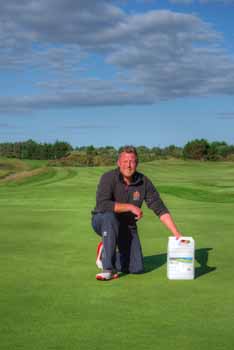
Founded in 1890 on the sea front links, Whitley Bay Golf Club in Tyne & Wear moved to its current location in 1906 and still lies within half a mile of the coast.
The town of Whitley Bay, while close, never intrudes into the scenic course, which presents generous fairways, bordered by undulating rough, gorse and large trees and is populated with a variety of wildlife.
A key feature is the Brierdene Burn, which runs through the course and must be carried from the 5th, 15th, and 16th tees and comes into play on the 12th.
At 6,579 yards, the par 72 course has hosted many national and county events over the years, including a European Tour event in 1977; The Callers.
More recently, significant improvements to the layout have taken place.
GreenKeeping speaks to the club’s course manager, Simon Olver, about his career and how he maintains such an outstanding venue.
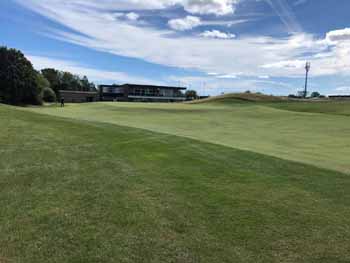
What was your path to greenkeeping and how long have you now been at Whitley Bay Golf Club?
At 16 I left school to become an apprentice greenkeeper at Dustanburgh Castle Golf Course. Over the next four years I was very close to Ken Day, Dunstanburgh’s long term head greenkeeper, while achieving an NVQ / SVQ level 2 at Elmwood College and NVQ level 3 with Myerscough College.
At the age of 20 I was offered the position of head greenkeeper as Ken embraced retirement. I jumped at the chance and the vast amount of information I had learned from Ken over the early years of my career was invaluable. I continued to learn my trade on this true links, operating with very limited resources and budgets. I was very comfortable at Dunstanburgh but required a project to gain further experience and an ability to highlight my skill-set; I moved to a parkland course called Percywood, the facility was extremely run down and regarded as one of the worst courses in the area (everyone thought I was mad).
Over the next six years I project managed a full golf course overhaul and improvement programme, which resulted in the course producing some of the finest putting surfaces in the north east of England.
In 2014, I accepted the position of course manager at the highly regarded Whitley Bay Golf Club, project managing a full course overhaul including major reconstructions works and grow-in, irrigation upgrade and installation along with environmental improvements and grass species transition with a focus on creating a sustainable model.
Between 2013 and 2018 I achieved my FdSc in sports turf management, and completed a BSc (hons) in sports turf science and management through the University of Central Lancashire.
I also obtained a Jacobsen higher education scholarship in 2012 and one of my proudest moments was becoming an R&A scholar in 2017. I was fortunate enough in 2015 to be part of the Bernhard delegation at the GIS show in San Diego. This was an invaluable experience which continues to this day to have a positive impact on my career.
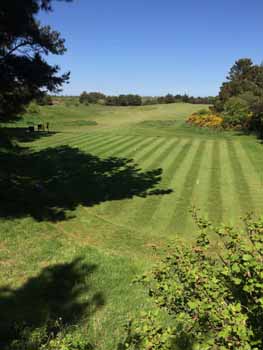
What is the size of your team, what are their names, how do you maximise the team and resources to ensure a high end product is delivered to the playing visitors?
There are six full-time plus a seasonal worker: Simon, Mark, Ben, Allan, Grant, Robbie and Adam.
The key focus is to ensure that everyone has an input and feels part of the team as it is their journey as well as Whitley Bay’s. We also encourage ongoing training to ensure all team members are kept up to date with modern techniques and technology. Embedding, open and honest culture and always approaching situations together as a team brings pride and motivation to everyone involved in our journey.
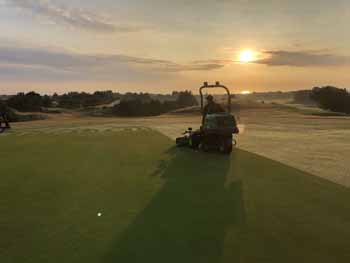
What would you say are the biggest challenges you currently face and how do these affect the daily maintenance?
Environmental pressure, financial constraints, bans on chemicals along with an ever-increasing demand for a pristine course with perfect surfaces based around what is now a 12-month sport, requires managers to create a sustainable model which can constantly perform within these desired parameters. A responsible approach to management requiring minimal inputs and disruption is now essential. Utilising all technology available to us and being attentive to the correct product selection for each specific site provides a winning combination.
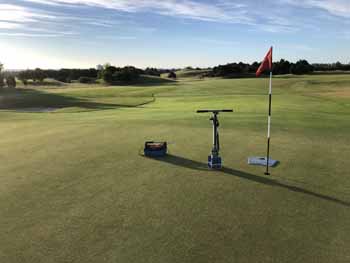
The course has a truly dynamic landscape, how did this come about and what drainage issues have you experienced and how have these been overcome? What are the plans to improve the drainage of the course moving forward?
The course has been mobile several times over the last 100 years, both with its location and layout. Originally, the current course layout was completely flat and in the 1960s the club made the decision to give the course up for a number of years to the National Coal Board for open cast works with the agreement that during reinstatement a dynamic landscape would be created.
Today’s course provides golfers with a unique experience which feels very much like a links course for the majority of the year, but subsurface ground conditions are heavy resulting in some localised drainage issues through the winter months.
Over the years, miles of drains have been installed to improve our situation and this work continues annually and is carried out in-house by the team in-line with the club’s ongoing management plan.
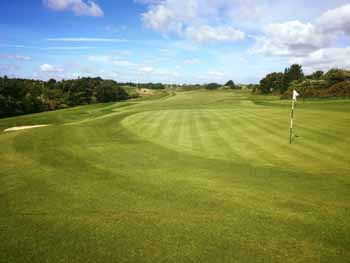
The last four years have been spent getting the environment of the course right. Exactly what programmes did you set in place to bring the course to its standard and consistency today and what’s in the plan moving forward?
Four years ago we started our journey to create a course which was financially sustainable, responsibly managed and one that could provide customers with a memorable golfing experience. At the beginning standards were not acceptable, playing surfaces were inconsistent and growing environments did not provide the foundations to create what was required. To rectify this, a plan moving forwards was implemented, initially to focus resources on creating an environment which could support these requirements, then improving sward composition through subtle species’ transition. Long-term plans targeted minimising any further disruption, reducing inputs and costs while creating a 12-month golf course which offers firm free rolling surfaces. If all of this is achieved I have no doubt that we will have created the best course in the north east of England.
To allow this to be financially achievable, focus throughout remained on reducing all unnecessary spend, a key area of this is product selection and application. Our ability to base all nutrient and chemical requirements / inputs around quantifiable data and site specific research removes unnecessary expenditure. A simplistic and traditional approach towards plant heath and performance application packages also reduces costs hugely, these savings can then be reallocated to increase spend on the technology which supports plant health, maximises product efficiency and creates synergy in an ever-changing and adverse environment.
The future for Whitley Bay Golf Club is exciting, as the course continues to evolve, disruption and applications will further reduce, these savings can be utilised to focus resources and technologies to improve the health and performance of less important areas around the course which in turn will directly improve course standards and the product we can offer to customers.
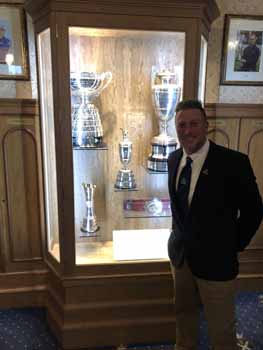
Over the last four years you and the team have making a positive impact on the environmental stewardship of the course. Exactly what have you done and what have you seen as a result of the hard work?
One of the first things we did as a club was join forces with James Hutchinson from BIGGA as our ecologist. James worked closely with the greenkeeping team and the club to create a bespoke environmental management plan; this allowed us to proactively plan work and annually monitor progress.
The team have been involved with several ongoing environmental projects in the last four years, our greatest success to date has to be the improvements made to grasslands around the course. These previously unmanaged and unplayable areas have been transformed into huge areas of diverse habitats which contain some of the largest populations of orchids I have ever seen on any golf course.
Everyone at Whitley Bay GC is thrilled with the progress we have made to both environmental conditions and course playability in a relatively short period. The icing on the cake for the club was to be selected as a finalist in the STRI Golf Course Environment awards in 2015 and 2016 for the award of Golf Course of the Year.
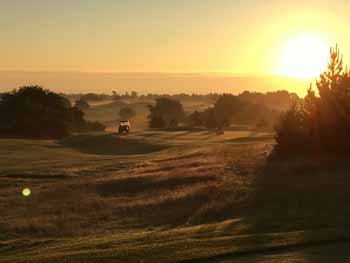
You mentioned the sward had become weak over the years and that you’d introduced an overseeding programme. What areas have you addressed, what were you looking to achieve, what cultivars did you opt for, what percentage population have you achieved to date, what’s the ultimate goal and more to the point, what has it done for the course?
Once sufficient improvements had been made to growing environments and some increase in the natural colonisation of finer grasses was noted, it was time to start our next step and introduce an overseeding programme which worked around the needs of the business. One main overseeding operation is carried out in August / September in combination which maintenance work. Fescue and bent are added in two separate operations during this period, optimum growing conditions and relaxed maintenance following periods of routine maintenance complements excellent establishment. Throughout the season overseeding is carried out on individual specific areas which assists ongoing improvements with very little disruption to golf.
All fescue seeding throughout the season is carried out using the pot seeding technique with smaller 10mm holes during any seeding works throughout the season at Whitley Bay GC. This allows new seedlings to establish with very little pressure from mechanical stress. Overseeding with bent is carried out using GreenTek Dyna seeders.
At first there were some concerns from the club during the period following pot seeding into large hollow core holes due to the initial disruption to surfaces, but this was very quickly adopted as our appropriate technique. Following establishment, the improvements were very impressive and winter putting surfaces became as good, if not better, than summer conditions.
Keeping an eye on various new cultivars available to the market is essential and the progress which has been made by seed companies over the last few years is fantastic. We work with a variety of suppliers during selection as most premium seed mixtures now only contain premier cultivars. I find that performance traits of all top rated cultivars vary slightly and rotating applied mixtures helps to build a balanced composition which can perform 12 months a year and stand up to ever-increasing pressure from levels of play along with environmental and mechanical pressure.
Whitley Bay GC customers now enjoy playing on full greens throughout the year which show very little change in performance. As populations of desirable grasses continues to increase year after year, further improvements with consistency and performance will follow suit.
In 48 months we have reduced levels of poa from around 80 to around 45 per cent and we are confident that this figure will continue to fall through continued responsible management and inputs of fescue and bent through overseeding operations.
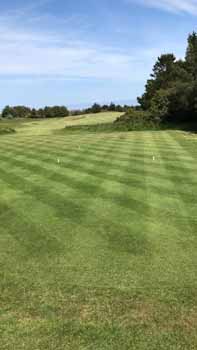
You work with Aquatrols, what sort of relationship do you have and what products do you use?
Aquatrols provide an excellent support network with fantastic technical assistance when required. They have been involved over the last four years from the start so this is also their journey to. As Whitley Bay continues to evolve into the course it is today an attentive focus by Aquatrols has assisted in achieving these results. Aquatrols have been great supporting any questions I may have along with answering my demands for onsite trials before any products have been used out on the course at Whitley Bay.
We use a range of Aquatrols products which have all been thoroughly trialled and tested on site before use to ensure they produce the results we require. The flexibility and consistency of nutrient and organic products have helped us produce great results.
Moisture management is key to our success and remains critical to further success and improvement. Revolution is applied in a programme to putting surfaces from February each year, in my eyes this remains the best surfactant available on the market today, helping to maintain balanced moisture levels even in the most testing of environments. It takes away all surprises meaning I can sleep easy at night.
Zipline has been used on tees and surrounds in 2018, the flexibility of this new product allows applications to be adjusted to deal with ever-changing conditions. Tank mixing capabilities also allow products to be applied together, meaning time can be saved and reallocated to other areas; in a small team any time which can be saved is fantastic. To have a moisture management tool available to us which also assists us with reducing the nutrient requirement is a fantastic addition to our programme.
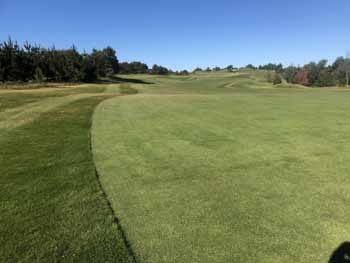
In terms of working towards a balance and consistency, do the products help with this?
The key focus at Whitley Bay GC is consistency – this lies somewhere between the acceptable upper and lower target standards. Discovering our maximum achievable standards and ensuring these are continually raised has ensured customer satisfaction. The range of Aquatrols products which we use around the course gives us full control throughout the year in ever changing conditions.
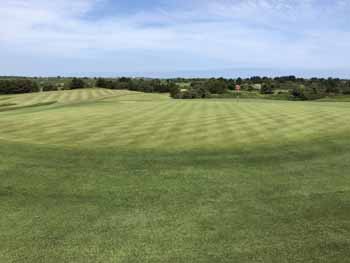
How do you see the benefits of Aquavita in the use of Zipline and do you feel you have reduced your nutrient inputs with the use of Zipline?
Simon Olver: With any product application, focus remains on achieving best efficiency and maximum benefits of that product, combining bio-stimulants and moisture management products with all applications increases synergy between biology and the environment. This helps to responsibly reduce any requirement of applied nutrients while still achieving desired results.
Aquavita contained within products is an exciting addition, this further assisted us to reduce unnecessary applications, creating an improved environment to support desired grass species and become overall a more sustainable model. After using Zipline throughout 2018 I am confident that the addition of Aquavita to our programme has allowed us to further reduced nutrient inputs.
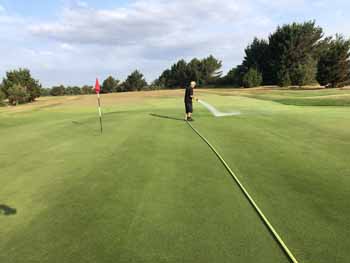
The course has recently had an irrigation upgrade, what form has that taken and how has this helped? Don’t you have a preference for hand watering?
Working with Full Circle irrigation, the course received a system upgrade which consisted of a new Hunter controller, valves, decoders and sprinkler heads. New pipe work was installed to all green complexes and surrounds. The installation of a radio kit has proved extremely useful during the application of products.
Hand watering allows water requirements to be specifically applied to target areas. Regular site appraisal using a moisture meter highlights any areas of low moisture which can then be addressed through hand watering. Also having the greenkeeping team standing on the green allows them to build up a better relationship with their putting surfaces, visual, feel, touch and data. All this information can then be filtered back into the ongoing maintenance plan and required adjustments can be made.
We target our main focus towards the planning and implementation of a successful moisture management programme using Aquatrols Revolution, we begin applying the product in February monthly through until July, which provides reliable protection. Preventative management to utilise available moisture instead of focusing on the application of water removes the need to worry about levels of available water throughout the playing season. Ensuring plant health remains satisfactory during the playing season really helps to reduce the costs and minimises any drain on resources, allowing this time to be allocated to other important areas.
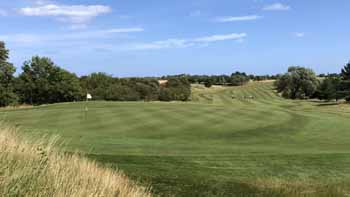
What machinery fleet are you currently using?
We mainly run a John Deere fleet, Greenlay, our local dealer, provides fantastic service and back-up which to me is essential. Over the last year we have purchased a JD 9000 rough mower and an 8000E three wheel fairway machine for mowing surrounds.
Both these machines stand out to me as the best machines which JD have produced over the last few years.
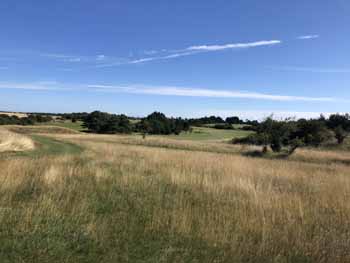
What do you think are the strengths that have carried you through your career and current position at Whitley Bay Golf Club and what are your goals for the course?
I have always approached turf management with a very traditional approach, utilising proven methodology of yesteryear, backing this up with modern technology, research and techniques, creating a winning combination.
Continued focus towards planned targets will ensure the ongoing development of the course at Whitley Bay, creating an amazing experience for our customers on the best course in the north east of England. I would love to see Open qualifying at Whitley Bay and I believe this is more than achievable in the next four years.

What height of cut do you use across the course and what man-hours are spent mowing?
Greens, 3.5mm to 6mm; tees, 9mm; fairways, 11mm; semi-rough, 38mm; primary rough, 57mm.
Man hours vary greatly across the season.
Training and education have been a big part of your development and for developing a good team, what do you do to ensure the club is investing in raising the standard of practice and performance of the greenkeeping team members?
Good solid communication between all departments and club management maintains a direct link highlighting the need for ongoing training and development by all involved. Improvements to course presentation and performance are testament to this and everyone at Whitley Bay plays a vital role. Their input, suggestions and ability to effectively react and deal with situations as they occur is only possible with ongoing investment in continued professional development.
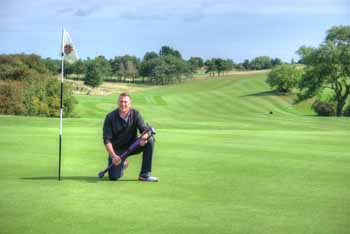
The pressures on the course manager to deliver a better product are growing year on year and the level of professionalism is rising with this. What do you think are the qualities now needed to meet the requirements and demands of members / players by someone in your position and how does this help contribute to the business of golf?
I feel that today’s course manager must perform on many levels the same as a manager in any other business or organisation. An in-depth knowledge of all course-related subjects is required, but they should also be suitably trained and experienced in other areas allowing them to play an active role in areas such as finance, planning, man-management, marketing and human resources. An individual’s ability to play a part in the overall management of a business will help deal with situations efficiently, allowing a business to perform well.
Course managers are now communicating with customers better than ever before through a range of various channels. Our ability to get information direct to our customers allows well-timed proactive and preventative communication to inform, address and educate a target audience. People around the world involved with the golf industry are becoming more aware of emotive areas of golf course management such as required operations, environmental pressures and site specific situations to name a few. Their understand of our industry will grow along with the respect they have for the work we do.
What currently gives you the greatest satisfaction from your job, how do you feel daily when you are moving around the course looking at what you and the team have achieved and what do you feel are your biggest achievements to date?
Simon Olver: Watching a course evolve and transform from the vision in my head is fantastic and seeing the look on customers’ faces who play the course is extremely satisfying. The team at Whitley Bay now present a course on a daily basis at a level which was only a dream four years ago, it goes without saying that everyone involved is proud of this achievement.
Throughout my career I have always enjoyed working with and training staff, this is what gives me my greatest satisfaction in my role. Watching the aspirations of both individuals and teams grow is amazing, this pride and ambition is without doubt the overwhelming factor which allows businesses and people to perform beyond expectations.
My own biggest achievement to date is to achieve my degree in sports turf science and management. I have never been an academic so for me to achieve this while balancing work and family is huge.
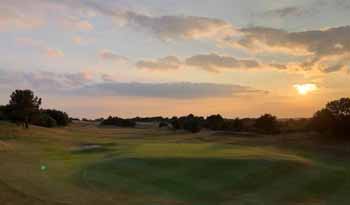
With your experience and achievements, what advice would you give to youngsters starting out and wanting to pursue a career in the profession?
Set yourself short, medium and long term goals, as you progress through your career review against these targets. Trust your own instincts, place yourself outside your comfort zone as frequently as possible and never let anyone tell you anything is unachievable.
The industry is changing and becoming ever-more based around science and subject knowledge so education is key – learn the trade then focus on high level education and as experience levels grow through your career, this will place you in a strong position and allow you to exceed your own expectations, getting that job you dreamed of.
What changes do you think need to be made to benefit the industry sector and profession of the greenkeeper?
Further improvements to education which focuses on standardising all industry-related training with benchmark pass grades for all levels.
I feel that in some areas education standards have been lost over the past few years as providers focus on the revenue that students generate instead of the quality of education which is delivered. As the pressure and demands continue to grow within golf clubs, it is essential that tomorrow’s greenkeepers are properly prepared and given the skills-sets to cope and perform at the level and standard that is expected.

























